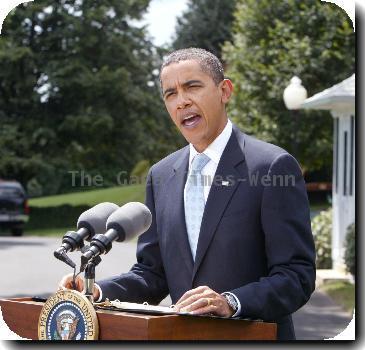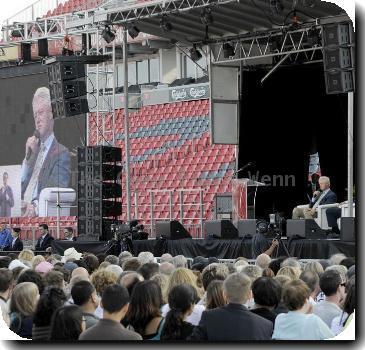Redistricting, a role in 2012 presidential race loom large in high-stakes governors races
By Tom Raum, APMonday, September 6, 2010
Sheer number, sour economy favor GOP in govs races
WASHINGTON — Never before have so many governorships been up for grabs — and with so much at stake.
The races come just ahead of once-in-a-decade congressional and legislative redistricting to reflect the U.S. population of the 2010 census, a process in which governors will play a central role. Of the 37 governorships on the ballot, more than half are open seats. And many of the contests are in prime 2012 presidential battleground states.
Democrats control 26 governorships and must defend 19 in November. Sheer math, the sour economy and historical trends favoring the out-of-power party in midterm elections suggest big Republican statehouse gains.
“We are now tasked with remaking the political map,” proclaims the website of the Republican Governors Association, headed by Mississippi Gov. Haley Barbour, a potential presidential candidate.
Republicans are hoping for eight or more pickups. “We can’t wait until 2012 to start taking our country back,” says Barbour.
Democrats are striving to minimize losses and pull off some upsets.
“We knew it was going to be a tough year just by virtue of the fact that we elected a Democrat to the White House in 2008,” said Nathan Daschle, executive director of the Democratic Governors Association. “History shows the president’s party loses 5.5 governors seats in midterm elections.”
Furthermore, the poor economy and growing tea-party activism are weighing on all incumbents and those perceived as establishment candidates.
“In a year like this, no one is safe,” Daschle said.
Underscoring the high stakes: The GOP governors association is poised to spend up to $65 million on the races; its Democratic counterpart, about $50 million.
Republicans’ best shot for pickups may be a string of governorships now held by Democrats across Great Lakes and upper Midwestern states, including Ohio, Michigan, Wisconsin, Illinois and Iowa as well as Pennsylvania.
Democrats have fewer opportunities for gains, although they appear on track to pick up Republican governorships in Hawaii, Connecticut and possibly Minnesota.
Both parties were pumping resources into high-profile campaigns in populous California, Texas and Florida, all won by Republicans four years ago. Democrats hope to add at least one of those big three to their column.
These have been particularly trying times for governors.
On the front line of the economic crisis, many have been forced to cut services or raise taxes — or both. And they’ve been bloodied by voter anger and the tea party movement sweeping the nation. Unlike the federal government, governors can’t print money and many are barred from deficit spending.
That, along with term limits in some states, is why so few sitting governors are running. Only 13 incumbents are on the ballot.
And some standing for re-election are in close races, including Democratic Govs. Chet Culver in Iowa, Ted Strickland in Ohio, Martin O’Malley in Maryland, even Deval Patrick in Massachusetts.
Governors in 31 of the 37 states on the ballot will have a pivotal role in redrawing congressional and legislative district lines. Whichever party has more control over the process is likely to get a larger number of favorable districts.
Rust Belt and upper Midwestern states are among the hardest hit by the Great Recession and provide some of the best hunting grounds for Republicans.
President Barack Obama recently campaigned for Ohio’s endangered Strickland in his race against Republican John Kasich, a former chairman of the House Budget Committee. Obama also stumped for Milwaukee Mayor Tom Barrett, who is struggling to keep the Wisconsin post in Democratic hands and faces the winner of a Sept. 14 GOP primary.
In Michigan, where unemployment is at 14 percent, Democratic Gov. Jennifer Granholm is finishing her term with slumping ratings. Republican businessman Rick Snyder has a big lead in polls over Democrat Virg Bernero, the mayor of Lansing.
In Illinois, interim Democratic Gov. Pat Quinn is weighed down by the Rod Blagojevich scandal. In Iowa, Culver must contend with popular former GOP Gov. Terry Branstad. In Kansas, the seat formerly held by Democrat Kathleen Sebelius — now secretary of health and human services — is open and retiring Republican Sen. Sam Brownback has a strong lead.
In the Northeast, Republicans captured New Jersey in a 2009 off-year election and now hope to capture open governorships now held by Democrats in Pennsylvania and Maine. In Pennsylvania, polls put Republican Attorney General Tom Corbett ahead of Democrat Dan Onorato, who is Allegheny County’s elected chief executive.
Democrats hope to pick up an open governorship now held by Republicans in Connecticut but face aggressive GOP challenges in two other New England states now held by Republicans: Rhode Island and Vermont. In Massachusetts, Patrick had appeared endangered, but he may be able to take advantage of a split in the anti-Patrick vote between a Republican and an independent candidate.
Democrats should be able to hold onto New York, with state Attorney General Andrew Cuomo as their nominee.
In the West, the top race is California, where Democrat Edmund G. “Jerry” Brown, a former governor and current attorney general, is running against former eBay chief executive Meg Whitman for the job being vacated by Republican Arnold Schwarzenegger. Whitman is breaking individual spending records, investing more than $104 million so far. Brown is one of five ex-governors seeking to get their old jobs back. Most polls put the race at a virtual dead heat.
In Colorado, Denver Mayor John Hickenlooper, a Democrat, may be able to keep the seat in Democratic hands as Republicans split support between establishment GOP candidate Dan Maes and former Republican Rep. Tom Tancredo, who is running as an independent. Democratic Gov. Bill Ritter dropped a re-election bid amid weak poll numbers
Democrats could have a hard time holding open governorships in New Mexico, Oregon and Wyoming.
In the increasingly GOP South, Republicans captured a Democratic governorship in Virginia in 2009 and polls show them ahead in the race for the open post now held by Democrats in Tennessee.
Republicans also lead in polls for the open seat now held by Democrats in Oklahoma, and they appear likely to keep open governorships in Alabama, Georgia and South Carolina.
Texas Gov. Rick Perry, a Republican, is favored over Democratic former Houston Mayor Bill White, but Democrats are pouring a lot of money into the race and hoping for an upset.
In Florida, wealthy businessman Rick Scott won a bitter GOP primary by tagging Attorney General Bill McCollum — a former longtime congressman — as the establishment candidate. Scott, a political newcomer, is running against Democrat Alex Sink.
Democrats see the state as a pickup prospect. Most polls see a toss-up. Florida’s governor, Charlie Crist, took office as a Republican but switched to independent in his Senate bid.
Governor jobs have long been known as fertile ground for future presidents, and there could some among this year’s bumper crop of new faces. Four of the past six presidents were governors first — Jimmy Carter, Ronald Reagan, Bill Clinton and George W. Bush.
Tags: 2012 United States Presidential Election, Barack Obama, Bill Clinton, Events, Florida, Iowa, North America, Ohio, Pennsylvania, Political Organizations, Political Parties, Sports, Stakes, United States, United States Presidential Election, Voting Districts, Washington



